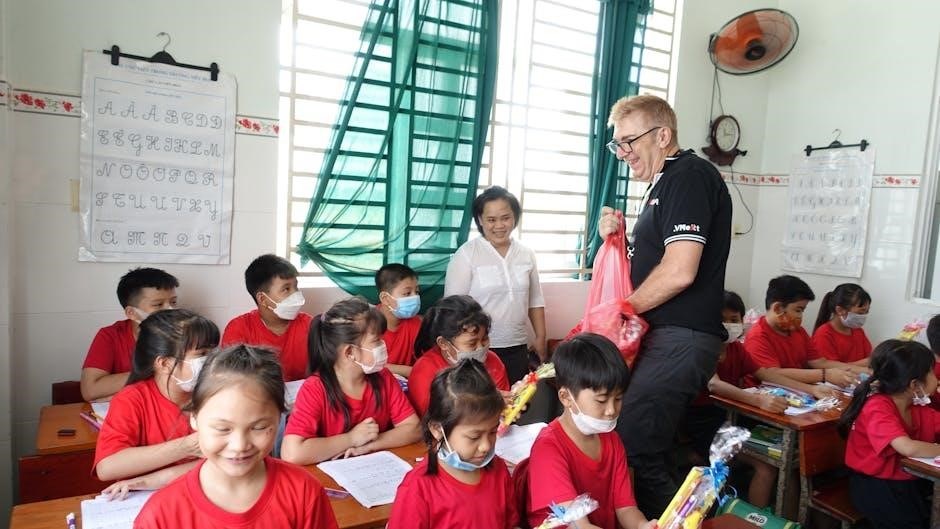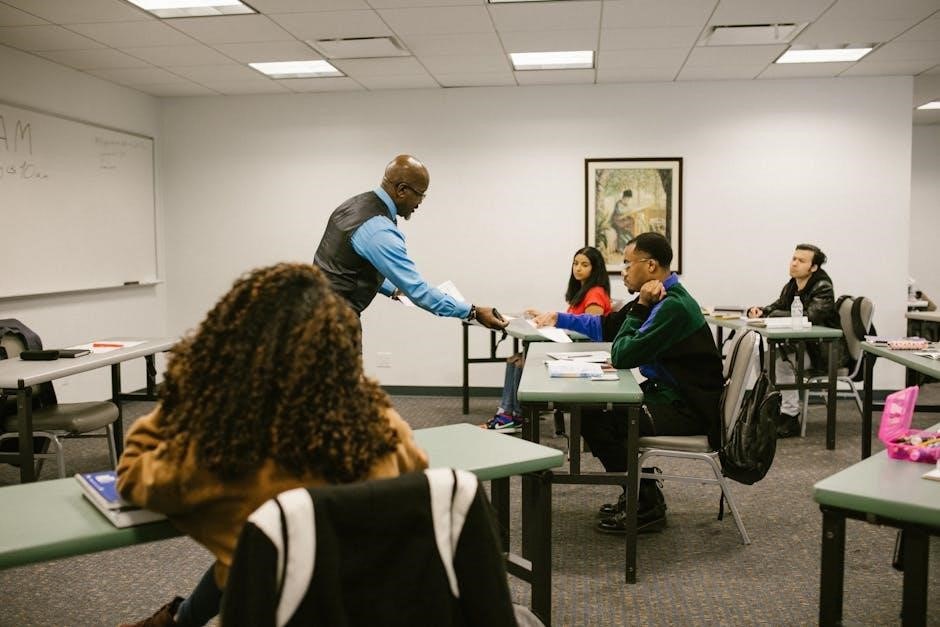Suitability for the Role
1.1. Why Did You Apply for This Particular Role?
The alignment of the school’s mission with my values and passion for fostering academic and spiritual growth in students inspired my application.
1.2. What Makes You a Strong Candidate for a Catholic School Environment?
My commitment to integrating faith into education‚ coupled with my experience in creating inclusive and faith-centered learning environments‚ positions me as a strong candidate.
I was drawn to this role because of the school’s commitment to fostering both academic excellence and spiritual growth. The opportunity to work in a faith-based environment where I can integrate Catholic values into teaching resonates deeply with my own beliefs and educational philosophy. I am eager to contribute to a community that prioritizes holistic development and supports students’ moral and intellectual growth.
My dedication to Catholic education‚ experience in faith integration‚ and ability to create a nurturing‚ values-driven classroom make me a strong candidate. I emphasize prayer‚ service‚ and moral development‚ aligning with the school’s mission to foster spiritual growth alongside academic achievement.

Teaching Philosophy and Methods
My philosophy centers on fostering a supportive‚ student-centered environment‚ integrating Catholic values‚ and using engaging methods to promote academic and spiritual growth effectively.
2.1. What Is Your Teaching Philosophy?
My teaching philosophy revolves around creating a nurturing‚ faith-infused environment where students feel valued and supported. I emphasize fostering a love for learning‚ critical thinking‚ and moral development‚ ensuring each child’s unique potential is realized through differentiated instruction and meaningful engagement.
2.2. How Do You Ensure Student Engagement in the Classroom?
I ensure student engagement through interactive and hands-on activities‚ incorporating technology‚ and fostering a collaborative learning environment. By connecting lessons to real-life experiences and integrating faith-based values‚ I encourage active participation and cater to diverse learning styles‚ making learning both meaningful and enjoyable for all students.

Classroom Management and Discipline
By setting clear expectations‚ using positive reinforcement‚ and fostering a respectful environment‚ I maintain effective classroom management while integrating faith-based values to guide student behavior.
3.1. How Do You Handle Discipline in the Classroom?
I handle discipline by starting each class with prayer‚ setting clear expectations‚ and using positive reinforcement; I encourage reflection and accountability while aligning consequences with Catholic values‚ fostering a respectful and orderly environment that promotes spiritual and academic growth.
3.2. How Do You Create a Positive Learning Environment?
I create a positive learning environment by starting each class with prayer‚ fostering respect‚ and encouraging inclusivity. I promote a growth mindset‚ celebrate individual strengths‚ and integrate Catholic values to build a supportive and compassionate community. This approach ensures students feel safe‚ valued‚ and motivated to thrive academically and spiritually.

Integration of Faith and Values
Faith is woven into daily lessons‚ starting with prayer and incorporating Catholic teachings. I model values like compassion and respect‚ fostering a faith-centered community.
4.1. How Do You Incorporate Catholic Values into Your Teaching?
I begin each class with prayer‚ setting a spiritual tone. Catholic values are integrated through moral discussions‚ service projects‚ and connecting faith to academic lessons‚ fostering a holistic education.
4.2. How Do You Support the Spiritual Growth of Your Students?
I support students’ spiritual growth by modeling Catholic values‚ encouraging participation in prayers and sacraments‚ and incorporating faith-based reflections into lessons‚ helping students connect their learning to their spiritual journey.

Lesson Planning and Preparation
I develop lesson plans that align with state standards‚ incorporating differentiated instruction to meet diverse learning needs and ensuring engagement through varied teaching strategies.
5.1; How Do You Develop Lesson Plans That Align with State Standards?
I begin by thoroughly understanding state standards and incorporating them into clear‚ measurable objectives. I align activities‚ assessments‚ and materials to ensure coherence‚ while integrating Catholic values and differentiated instruction to meet diverse learner needs. Regular reviews and adjustments ensure lessons remain relevant and effective‚ fostering both academic and spiritual growth.
5.2. How Do You Differentiate Instruction for Diverse Learners?
To cater to diverse learners‚ I employ varied instructional strategies‚ including differentiated materials‚ technology integration‚ and flexible grouping. I assess individual needs and adapt lessons to accommodate different learning styles‚ ensuring all students can access the curriculum. Regular progress monitoring and collaboration with colleagues further support tailored instruction‚ fostering an inclusive and engaging learning environment.
- Utilize varied instructional strategies
- Assess individual learning needs
- Adapt lessons for diverse learners
- Incorporate technology for engagement

Assessment and Feedback
6.1. How Do You Assess Student Progress?
Assessment is conducted through quizzes‚ class participation‚ and project-based evaluations to monitor comprehension and skill development‚ ensuring a comprehensive understanding of student growth.
6.2. How Do You Provide Constructive Feedback to Students?
Feedback is tailored to individual needs‚ emphasizing strengths and areas for improvement‚ delivered respectfully to encourage growth and self-confidence in students.
I assess student progress through a combination of quizzes‚ class participation‚ and project-based evaluations to monitor comprehension and skill development. These methods help identify areas where students may need additional support. Regular progress monitoring ensures that lessons are tailored to meet individual and group needs effectively.
I provide constructive feedback by highlighting strengths and offering specific‚ actionable suggestions for improvement. Verbal and written feedback is given promptly‚ ensuring students understand expectations and feel supported. This approach fosters a growth mindset‚ encouraging students to reflect on their work and strive for continuous improvement in a positive and encouraging learning environment.

Professional Development
7.1. How Do You Stay Updated with Educational Trends?
I stay updated by attending educational workshops‚ participating in webinars‚ and engaging with professional networks to incorporate innovative teaching strategies and best practices.
7.2. How Do You Collaborate with Colleagues?
I collaborate through regular team meetings‚ peer observations‚ and sharing resources‚ fostering a supportive environment where educators can grow and contribute collectively to student success.
I stay updated by attending educational workshops‚ participating in webinars‚ and engaging with professional networks. I also prioritize reading industry publications and leveraging online resources to remain informed about best practices in education‚ ensuring I can integrate innovative strategies into my teaching while aligning with the Catholic school’s mission and values.
I collaborate with colleagues through regular team meetings‚ shared planning sessions‚ and open communication. I believe in fostering a supportive environment where ideas are shared freely‚ and we work together to achieve common goals‚ ensuring a cohesive and effective approach to education that benefits both students and the school community.

Parent-Teacher Collaboration
I foster collaboration through regular communication‚ including emails‚ newsletters‚ and parent-teacher conferences‚ ensuring parents are actively involved in their child’s educational journey and development.
8.1. How Do You Communicate with Parents?
I maintain open and consistent communication with parents through emails‚ newsletters‚ and parent-teacher conferences. I also utilize digital platforms to share updates on student progress and involve parents in their child’s education‚ fostering a collaborative and supportive partnership between home and school.
8.2. How Do You Involve Parents in Their Child’s Education?
I involve parents by encouraging volunteering‚ attending school events‚ and participating in parent-teacher organizations. I also provide resources for at-home learning and invite parents to share their skills or cultural experiences in the classroom‚ fostering a collaborative partnership that supports their child’s academic and personal growth;

Student Engagement and Motivation
9.1. How Do You Motivate Students to Learn?
I use interactive activities‚ hands-on learning‚ and technology to make lessons engaging and relevant‚ fostering curiosity and a love for learning in students.
9.2. How Do You Encourage Critical Thinking and Creativity?
I promote critical thinking through open-ended questions and problem-solving tasks‚ while encouraging creativity by allowing students to express ideas and explore innovative solutions freely.
I motivate students by fostering a supportive environment‚ incorporating hands-on activities‚ and connecting lessons to real-life experiences. Recognizing progress and celebrating achievements also encourage engagement and perseverance‚ helping students develop a love for learning and confidence in their abilities‚ aligning with the values of a Catholic education.
I encourage critical thinking through project-based learning and open-ended questions. Creativity is fostered by allowing students to express their thoughts and explore diverse solutions. Incorporating art and imaginative activities promotes innovation‚ while aligning with Catholic values that emphasize curiosity‚ compassion‚ and the development of the whole child.

Strengths and Areas for Growth
My greatest strengths include strong organization‚ effective lesson planning‚ and fostering a positive classroom environment. I continuously work on integrating more technology into my teaching practices.
10.1. What Are Your Greatest Strengths as a Teacher?
My greatest strengths include strong organizational skills‚ the ability to create engaging lesson plans‚ and fostering a positive‚ inclusive classroom environment. I excel at building strong relationships with students‚ parents‚ and colleagues‚ which enhances collaboration and student success. My patience‚ creativity‚ and commitment to integrating faith and values into education further strengthen my teaching practices and student outcomes.
10.2. What Are Your Areas for Professional Improvement?
I continuously seek to enhance my technology integration skills and explore innovative teaching strategies to meet diverse learning needs. Additionally‚ I aim to refine my assessment methods to provide more personalized feedback. Staying updated on educational trends and seeking advanced certifications are key areas I am actively pursuing to further elevate my teaching practices and student outcomes.




